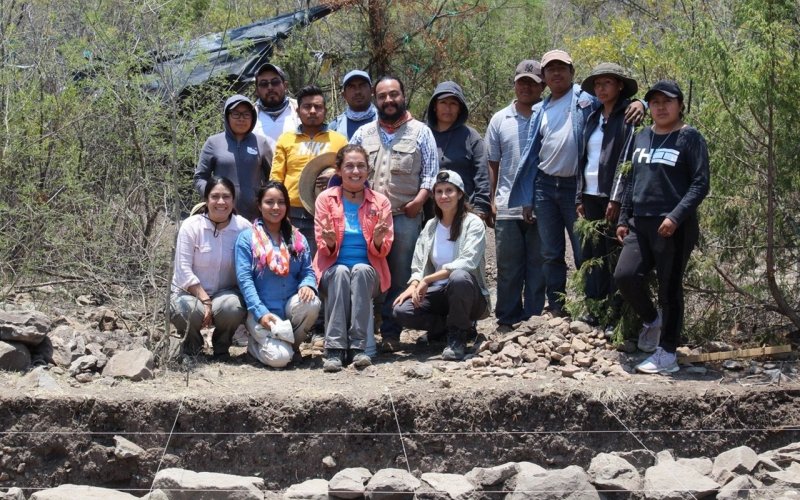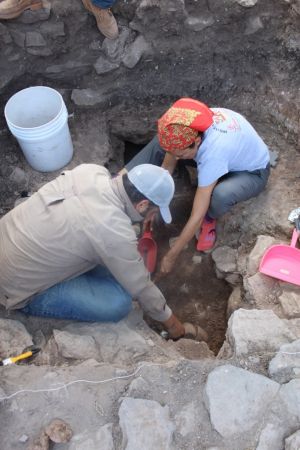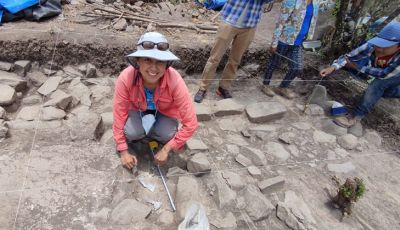Fulbright Scholar Studies Ceramics for Clues to Sociopolitical Dynamics of Oaxaca's Earliest Cities

ALBANY, N.Y. (Sept. 8, 2022) – A University at Albany anthropologist will spend her academic year in the hills of Oaxaca, Mexico investigating the origins of pottery unearthed from two pre-Hispanic sites to see if they can provide clues to the social and political dynamics guiding some of the world’s earliest cities.
Verónica Pérez Rodríguez, an associate professor of anthropology who was recently named a Fulbright-Garcia Robles Science and Technology Global Scholar by the U.S. Department of State, will conduct chemical and petrological analyses of ceramic vessels excavated from the ancient city of Cerro Jazmín to determine whether they were locally made or hailed from the politically powerful Monte Albán region, now an archaeological site.
The sites were some of the earliest cities in the world, forming around 300 and 500 B.C., respectively. And while they may be considered close by modern standards, they would have been a four-to-five day trek through mountainous terrain at the time both were active, Pérez Rodríguez said.

“When cities first emerged here in Oaxaca, the elite members of Monte Albán started wining and dining with a particular type of pottery called crema,” she said. “So when people wanted to join the club of being urban and part of this cosmopolitan sphere, we start seeing this pottery show up on site.”
The vessels unearthed at Cerro Jazmín are stylistically similar to the crema vessels found in Monte Albán, which are believed to have become status symbols. Pérez Rodríguez wants to know whether the vessels actually came from Monte Albán, which would indicate trade relations and the region’s political influence over other cities, or whether they were locally made knock-offs.
“These pieces are very beautiful and fragile and would have had to be carried on people’s backs, on foot,” she said, noting that animals weren’t used to help transport goods until the Spanish arrived centuries later.
For this reason, she suspects the crema-like vessels may have been imitation goods meant to convey status and power — and that carries social and political implications.
“Even if you do a knockoff, you still have to have knowledge of what the pieces should look like,” she said. “There’s got to be some transmission of knowledge there. And what makes people want access to this particular type of pottery in the way, you know, people today may want access to a Rolex or Louis Vuitton purse?”
Pérez Rodríguez will undertake her research with Dr. Nelly Robles and the Atzompa Monumental Complex Archaeological Project (PACMA) in Oaxaca. Atzompa was a satellite city of Monte Albán that produced much of its pottery. Known today as Santa María Atzompa, it continues to have a strong and active pottery making tradition today.
Through the partnership, Pérez Rodríguez will have access to ancient pottery from Atzompa which she will compare with that found at the Cerro Jazmín site. She will also design and document ethnoarchaeological and experimental studies, relying on the female artisans living there today who still make pottery in the historic tradition to understand more about the process and even restore pieces for eventual placement in museums.
Pérez Rodríguez believes her work can provide insight into the sociopolitical dynamics that guided members of the earliest human cities. At the time, cities were a relatively recent human innovation (aided largely by agricultural practices that led to food surpluses), but people still had to be convinced to leave an old way of life for a new one, she said.
“For some reason, between 500 to 300 B.C., all over Mesoamerica people are becoming more urban and more complex,” she said. “And my work investigates the tools, the social strategies that made that happen. How do you convince people to come to a city and then once they’re there, how do you get them to stay?”

These insights are applicable today as climate change makes parts of the world increasingly inhabitable, she said.
The city of Cerro Jazmín is located in the hilltops and relied on a creative system of terracing and hydraulic engineering to sustain agriculture and food production right in the city. This is contrary to most modern cities, which rely on outside food production from rural areas to feed their populations. In addition, the ideological threads connecting city dwellers — a desire for culture, connection and shared identity — is fraying.
The pandemic-era rush of city dwellers fleeing to rural areas is the latest sign of this, Pérez Rodríguez believes. She suspects this trend may accelerate ongoing attempts at reimagining cities for the future.
“I love living in cities, but I also recognize that it doesn’t come without a price,” she said. “So how do you make cities that are livable and sustainable and long lasting? It may seem strange that I’m studying pottery. But I’m also studying power and spheres of influence and information and how it connects to the bigger picture of what sort of society you’re living in and what sort of society is emerging, which is a question I think we’re all grappling with today.”




